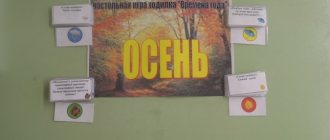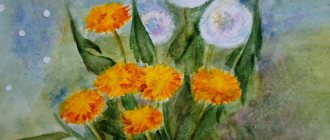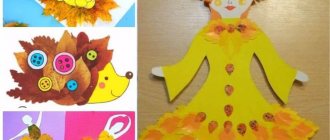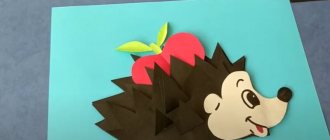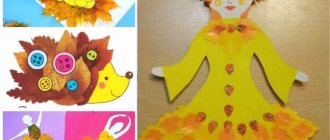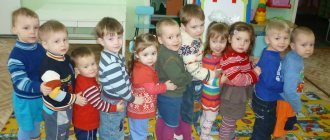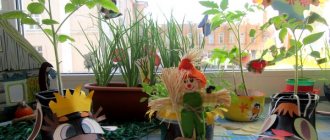Rowan sprigs
Kireeva Natalya Yurievna Bocharova Galina Viktorovna educators MADOU “Kindergarten of a combined type No. 7” Shebekino, Belgorod region
Rowan twigs lesson notes on the educational field “Artistic Creativity” in the second junior group
Program content:
- To instill in children an interest in visual arts and a love of nature;
- Develop children's skills in drawing rowan berries using finger painting (drawing with one finger);
- Strengthen knowledge about color;
- Develop fine motor skills of children's fingers;
- Activate the word: bunch in children’s speech.
Preliminary work:
- studying a rowan branch;
- examination of illustrations depicting a bullfinch;
- viewing the paintings “Autumn”.
Progress of the lesson:
Advertising message
- Guys, let's hold hands and smile at each other. Oh, do you hear someone knocking on our door. These are birds, and they brought us a package. And there is a letter in the parcel. “Dear guys, the bullfinch birds are writing to you. We want to ask you for help. Winter is coming soon, and we haven’t stocked up on berries at all. What should we do? Help!!! In gratitude, we send you our favorite painting.” Shall we help the bullfinches? How can we help? (let's draw berries). Let's look at what kind of gift the birds sent us.
- Look carefully at the picture. What do you think is shown there? (Birds)
In the picture we see how a flock of migratory birds flies away to warmer climes. Because the cold winter will come soon, and it will be difficult for the birds to find food. But not all birds are afraid of cold and frost. Some of them remain for the winter. And now I want to tell you about a bird that flies to our region for the winter.
This bird is a bullfinch. The bullfinch got its name because it flies to us along with the snow and lives all winter.
Black-winged, red-breasted, And in winter it will find shelter. He is not afraid of a cold, With the first snow it’s right there.
The bullfinch is a beautiful, calm bird. Look carefully and remember what it looks like. The top of its head, wings and tail are black. And the chest, belly and cheeks are red. The bullfinch's beak is short, thick, and black.
- Kostya, what is the name of this bird? (Bullfinch)
- Ira, tell me what the bird has? (torso, wings, head, legs)
- Kirill, what color are the bullfinch’s feathers? (Red and black)
Guys, let's imagine that you and I also became bullfinches.
Physical school:
They spun, spun (spun in place) And everyone turned into birds (straightened their arms) Come on, birds, flew (waved their arms) They flew and squatted (squatted down) Pecked some grains (knocked their fingers on the floor) Played in the pole (spun on place) They drank water (wave their head up and down) Washed their feathers (put their hands on their belts, connect their elbows) Looked to the sides (tilted their heads left and right) And flew back to their place (sat on chairs)
Well done boys! We take our seats. Let's help our bullfinches and draw them a treat. Most of all, bullfinches love rowan berries.
Look at the rowan branch:
a slender rowan in the yard, an emerald on the branches, in the morning at dawn. There are a lot of red berries, hanging in clusters. Their outfit is beautiful.
- -What color are rowan berries? (Red)
- -What shape are they? (Round)
- -What size are they? (Little ones)
That's right, guys. There are many, many small round red berries on a rowan branch. Look carefully at how friendly her berries are, growing one next to the other. There are many berries collected in a brush or bunch. Let's all repeat the word "bunch" together.
– Look, the bunches are directed downwards, like our fingers (show).
- Look, there are no brushes on the tables, so what do we use to paint with, what do you think? (Fingers)
- That's right, with our skillful fingers.
– Show me your magic fingers, here they are. Now, hide, there are no fingers. Now show it again, now hide it. Now show us the fingers with which you will draw (some people draw only with their index finger, and some with two).
- And here is my magic finger, which I will use to draw.
– Let us draw rowan branches for bullfinches. First, you need to dip your finger in gouache, like this, and look, guys, my finger has become colored! Now I put my fingerprints on a piece of paper. Like this. Many times. After all, mountain ash also has a lot of berries. If I run out of paint, I dip my finger in the paint again. Now you can get to work. (Calm music sounds)
- Lera, what are you drawing? (To Rowan).
- Dasha, what color of paint did you put on your finger? (Red)
- Kostya, what kind of rowan berries do you get? (Red, round, small)
- Guys, who drew the rowan, carefully wipe your finger with a damp cloth.
- Guys, what did we draw today? (To Rowan)
- For whom did we draw rowan? (For bullfinches)
- Veronica, tell me how you painted the rowan? (Finger)
- Well done boys!
You got very good and beautiful rowan branches. Bullfinches will really like them, and they will delight you with their bright outfit all winter! Next time we will draw grains for our bullfinches. Guys, where are we going to hang the picture? It became very elegant in our group. Let's help all the birds in the yard when we go for a walk. Let's fill their feeders with seeds. Abstract from the printed collection “Preschool and primary education - modern methods and technologies of teaching and upbringing”
Preview:
Summary of GCD for drawing in the first junior group
Theme: “Autumn leaves”
Target. Arouse interest in the topic of the image and its acceptance by children.
teach children the ability to apply dots with light movements using cotton swabs;
develop rhythmic movements;
consolidate knowledge of primary colors, encourage children to name them.
to cultivate an emotional response to autumn nature.
Visual: showing how to draw with cotton swabs.
Verbal: questions, explanations from the teacher.
Practical: teacher assistance to each child in mastering the method of drawing with cotton swabs.
Gaming: surprise moments, playing with ready-made drawings.
a sheet of paper with a picture of a tree (according to the number of children),
trays (according to the number of children),
gouache (yellow and red) (according to the number of children),
cotton swabs (according to the number of children).
Visual material: easel, sheet of paper with a picture of a tree (teacher demonstration), yellow paint, toy hedgehog, basket with autumn leaves, apples, cotton swabs.
Preliminary work: watching leaf fall on a walk, from a window in a group, looking at paintings about autumn, singing songs, listening to poems on autumn themes.
Children sit on chairs in a semicircle.
Educator: Children, what time of year is it now?
Educator: Why do you think so? (children's answers).
Educator: That's right, autumn. Because it’s cold, we wear warm clothes, and the leaves on the trees have turned yellow and red.
Educator: Oh, someone is knocking on the door. I'll go have a look.
The teacher returns with a toy hedgehog.
Hedgehog: Hello, children! I walked past your garden and heard you playing here, having fun. Can I play with you? (children's answers).
Educator: Hello, hedgehog, of course you can.
Hedgehog: And I brought you gifts. In the forest, the leaves fell off the trees and I brought them to you.
Educator: Thank you, hedgehog. Come on, children, let's play with colorful leaves.
(The teacher takes leaves from the basket and distributes them to the children.)
(Children stand in a semicircle.)
Breathing exercises “Wind and leaves”.
Children pretend to be the wind and blow on the leaves. (repeat 3 times). After the exercise, the teacher invites the children to put the leaves on the floor.
Hedgehog: Children, I also brought you “magic wands.” I want you to draw autumn leaves on the tree with them.
(The teacher takes out cotton swabs from the basket.)
Educator: What interesting sticks! Well, children, let's draw leaves with “magic wands”?
(The teacher invites the children to sit at the tables.)
(The teacher shows techniques for drawing leaves on an easel. After the demonstration, he distributes sticks to the children)
(During the practical performance of work by children, the teacher conducts individual work with each child.)
The teacher lays out the drawings on a separate table. He examines them together with the children.
Children take leaves from the floor and do exercises to the text of the poem.
Leaf fall, leaf fall, Hands with leaves at the top “swing”.
Yellow leaves are swirling. The children are spinning.
Leaf fall, leaf fall. Hands with leaves at the top “swing”.
Leaves are flying in the wind. Children are running around in all directions.
Spun around, circled around. The children are spinning.
And they sank to the ground. They squat down.
Summary of a drawing lesson in the junior group “Autumn Leaves”
Karimli Ziba
Summary of a drawing lesson in the junior group “Autumn Leaves”
Notes on drawing in the junior group “Autumn Leaves”
Tasks.
1. teach children the ability to apply dots with light movements using cotton swabs;
2. arouse interest in the topic of the image and its acceptance by children.
1. develop rhythmic movements;
2. consolidate knowledge of primary colors, encourage children to name them.
Educational: to cultivate an emotional response to autumn nature.
Methods and techniques:
Visual: showing how to draw with cotton swabs.
Verbal: questions, explanations from the teacher.
Practical: teacher assistance to each child in mastering the method of drawing with cotton swabs.
Gaming: surprise moments, playing with ready-made drawings.
Handout:
• a sheet of paper with a picture of a tree (according to the number of children,
• trays (according to the number of children,
• gouache (yellow and red) (according to the number of children,
• cotton swabs (according to the number of children).
Visual material: easel, sheet of paper with a picture of a tree (teacher demonstration, yellow paint, toy hedgehog, basket with autumn leaves, apples, cotton swabs.
Preliminary work: watching leaf fall on a walk, from a window in a group, looking at paintings about autumn, singing songs, listening to poems on autumn themes.
Progress of the lesson
The teacher draws the children's attention to the fact that someone is knocking on the door. (Brings a toy hedgehog)
.
Look who came to us? (hedgehog)
.
What is he like? (prickly)
.
What's on his back? (
leaves ) .
What color are they? (yellow, red, green)
.
Why are they this color? (
Autumn ) Educator: Do you remember how we collected colorful leaves on a walk and played with them ?
Educator: Let's play with them again and remember the game. You just have to be very careful. Autumn leaves are very fragile and break quickly.
Summary of a drawing lesson in the first junior group “Autumn leaves are flying”
Irina Chernova
Summary of a drawing lesson in the first junior group “Autumn leaves are flying”
Topic: “ Autumn leaves are flying ”
Goal: Learn to notice the beauty of nature in autumn . Continue introducing children to brushes and paints. Learn to hold a brush correctly and apply strokes to a sheet of paper using the dabbing technique.
1. Consolidate knowledge of yellow, red, green colors
2. Develop fine motor skills of fingers, imagination, memory.
Medium: multi-colored leaves , yellow and red gouache, brushes, album sheet with a painted tree , toy hedgehog.
Methods: surprise moment, questions for children, demonstration, integrated approach, encouragement.
Preliminary work: Observations of wind, rain, sun, sky. Looking at autumn leaves . Games “We are autumn leaves ”
,
"Sun and Rain"
.
“
In Autumn ” by S. Maykapar .
Form of organization of children: frontal
